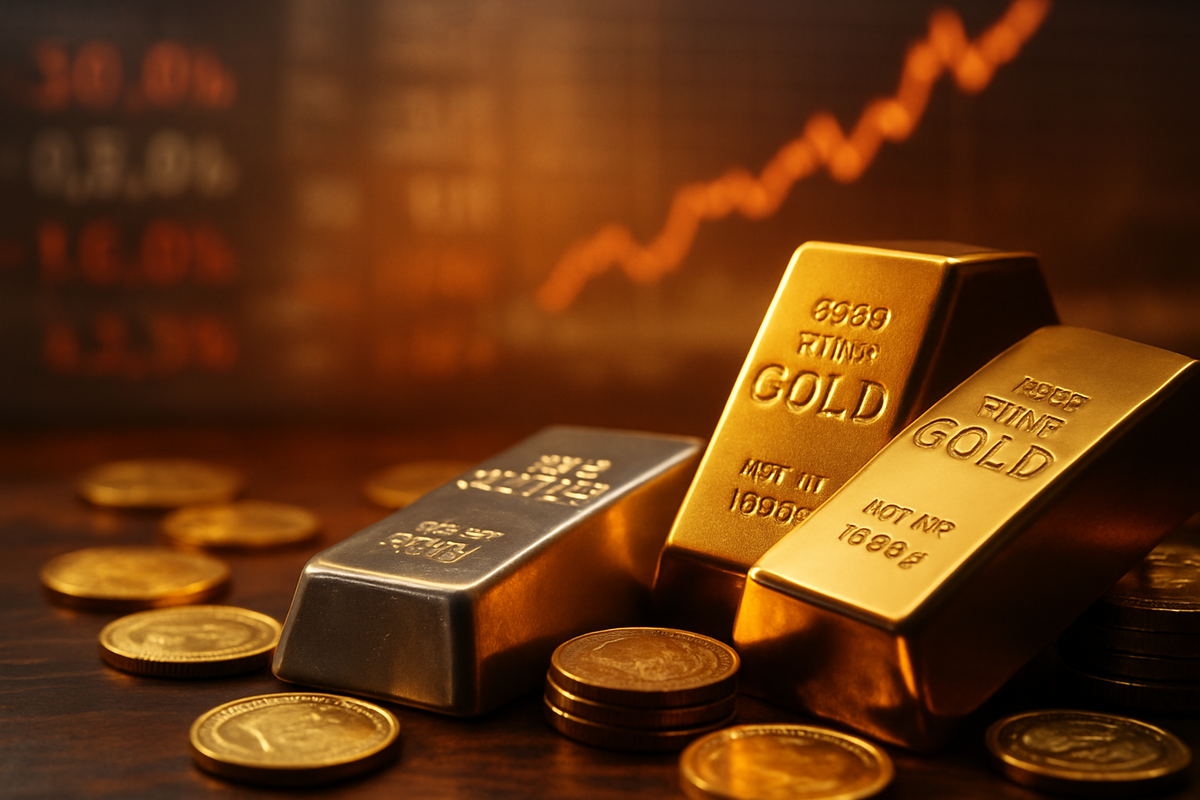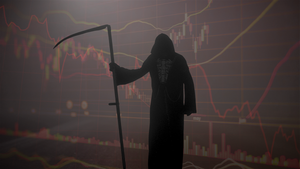
October 21, 2025 – As inflation continues to cast a long shadow over global financial markets, precious metals, particularly gold and silver, have surged to unprecedented levels, reflecting deep-seated investor anxieties and a flight to safety. With inflation consistently ranking as the paramount concern for investors in October 2025, the allure of these traditional hedges against economic uncertainty has intensified, driving their prices to historic peaks and significantly influencing portfolio strategies worldwide.
The immediate implications of this inflationary environment are profound, manifesting as a heightened demand for tangible assets, a recalibration of investment portfolios towards perceived safe havens, and a palpable sense of cautious optimism that pervades other market segments. This dynamic interplay between economic anxieties and investor behavior is reshaping the landscape of commodity markets, signaling a pivotal moment for both seasoned and novice investors alike.
Precious Metals Ascend to Uncharted Territory as Inflation Bites
The current inflationary climate has unequivocally propelled gold and silver into uncharted price territory. On October 16, 2025, gold (XAU) shattered previous records, reaching an astonishing $4,379.96 per ounce, having already breached the $4,000 milestone earlier in the month. Not to be outdone, silver (XAG) simultaneously achieved its own all-time high, touching $54.3775 per ounce. This monumental rally underscores the metals' enduring role as a bulwark against currency debasement and a reliable store of value when economic stability is questioned. Gold's performance has been particularly striking, with its price appreciating approximately 85% between December 2019 and October 2025, significantly outpacing the 23% rise in the U.S. Consumer Price Index (CPI) over the same period, validating its status as an effective inflation hedge.
The timeline leading up to this moment has been characterized by persistent inflation concerns throughout 2025. While some anticipated a moderation, the reality has been a continued upward pressure on prices. In the United States, headline inflation, which was 2.7% year-over-year in July, is projected to accelerate to 3.1% annually by October 2025. The highly anticipated September CPI report, crucial for the Federal Reserve's (the Fed) policy decisions, is slated for release on October 24th, with core CPI also expected to maintain a 3.1% year-over-year pace. The Fed's current target range for the federal funds rate stands between 4.25% and 4.50%. Geopolitical tensions, economic uncertainty, an ongoing US government shutdown, and trade wars have further bolstered the safe-haven appeal of these metals.
Key players in this unfolding drama include central banks, particularly the Federal Reserve, whose monetary policy decisions, including anticipated rate cuts following a September reduction, contribute to a weaker US dollar. A dovish monetary policy trajectory reduces the opportunity cost of holding non-yielding assets like gold and silver, making them more attractive. Institutional investors have also played a significant role, with substantial inflows into metals exchange-traded funds (ETFs) and physical silver contracts. Silver ETFs alone saw nearly 11 million ounces in inflows in the week ending October 16, 2025, while gold ETFs have accumulated 634 tonnes year-to-date. Retail investors, prioritizing inflation protection, have also flocked to these assets.
Initial market reactions to these record highs have been largely bullish, reflecting the broad-based demand. However, the market has not been without its moments of volatility. On October 21, 2025, gold experienced its largest single-day drop since August 2020, falling over 5%, attributed to profit-taking, easing trade tensions, and the conclusion of India's gold-buying season. Silver also saw profit-taking after its record-setting run. Despite these short-term fluctuations, the underlying narrative remains strong, especially for silver, which benefits from tight liquidity, soaring lease rates, and a fifth consecutive global supply deficit, coupled with robust industrial demand from sectors like solar photovoltaics.
Corporate Fortunes: Who Wins and Who Loses in the Precious Metals Boom
The sustained rally in gold and silver prices, driven by persistent inflation concerns, is creating a clear delineation of winners and losers across the corporate landscape. Companies directly involved in the extraction, financing, and investment of precious metals are reaping significant benefits, while industries reliant on these metals as raw materials face considerable headwinds.
At the forefront of the beneficiaries are gold and silver mining companies. These producers experience a direct and substantial boost to their revenues and profit margins. As the price per ounce of the metals they extract increases, their operational leverage allows profits to expand at a faster rate than costs, leading to improved cash flow, potential dividend increases, and opportunities for stock price appreciation. Major gold miners like Barrick Gold Corp. (NYSE: GOLD), Newmont Corporation (NYSE: NEM), and Agnico Eagle Mines Limited (NYSE: AEM) are poised for enhanced profitability. Similarly, silver-focused producers such as Pan American Silver Corp. (NASDAQ: PAAS), Fresnillo PLC (LSE: FRES), and First Majestic Silver Corp. (NYSE: AG) are seeing their bottom lines swell. Smaller, pure-play silver miners, despite higher risk, could see even more dramatic gains.
Precious metal streaming and royalty companies also stand to gain immensely. Firms like Wheaton Precious Metals Corp. (NYSE: WPM) and Franco-Nevada (TSX: FNV, NYSE: FNV) provide upfront capital to miners in exchange for future production at fixed, low costs or a percentage of revenue. This model allows them to benefit from rising spot prices without the direct operational risks and costs of mining, ensuring robust and expanding margins. Furthermore, investment firms and Exchange-Traded Fund (ETF) providers are experiencing increased investor interest. As individuals and institutions flock to gold and silver as inflation hedges, popular ETFs such as SPDR Gold Shares (NYSEARCA: GLD) and iShares Silver Trust (NYSEARCA: SLV) are seeing significant inflows, leading to higher assets under management (AUM) and increased management fees, thereby boosting the profitability of their managing firms.
Conversely, industries that utilize gold and silver as primary raw materials are facing significant pressure. Jewelry manufacturers and retailers are particularly vulnerable. Companies like Signet Jewelers (NYSE: SIG), Pandora (CPH: PNDORA), and Tiffany & Co. (NYSE: TIF) must contend with soaring input costs. This forces them to either absorb higher expenses, which compresses profit margins, or pass them on to consumers through elevated retail prices. The latter often results in reduced sales volumes as consumers opt for lighter pieces, alternative materials, or postpone purchases, as seen with brands like Mejuri and Melanie Auld already raising prices.
The industrial demand for silver, which accounts for over 50% of its usage, means that electronics manufacturers, solar panel producers, and medical device companies are also significantly impacted. Silver's exceptional electrical conductivity makes it indispensable in printed circuit boards, RFID chips, solar panels, and medical devices. High silver prices translate directly into increased production costs. For example, the share of silver in solar module production costs surged to an estimated 14% in 2025, up from 5% in 2023. Companies like First Solar, Inc. (NASDAQ: FSLR) could see their profitability squeezed if they cannot effectively pass these costs onto consumers or find viable, cost-effective alternative materials, which is often challenging given silver's unique properties. Lastly, mining companies with high production costs or substantial debt, as well as any entities holding significant short positions in precious metals, could face considerable financial strain.
Broader Implications: A Shifting Global Economic Order
The extraordinary surge in gold and silver prices transcends mere market fluctuations; it is a potent indicator of profound shifts in the global economic and geopolitical landscape. As of October 21, 2025, the sustained rally in precious metals is intricately linked to broader industry trends, including an accelerating deglobalization, the burgeoning energy transition, and a fundamental re-evaluation of monetary policy and international trade.
This phenomenon fits squarely into the ongoing trend of deglobalization. The renewed and aggressive phase of the US-China trade war, characterized by expanded US sanctions on Chinese firms and new export restrictions on critical rare earths from China, exemplifies a broader retreat from integrated global supply chains. This "supply-chain siege" fosters increased market uncertainty, compelling companies to diversify and localize production, which in turn contributes to inflationary pressures and bolsters the demand for safe-haven assets. Concurrently, the accelerating trend of de-dollarization by foreign investors and central banks, evidenced by the U.S. dollar's declining share of global foreign exchange reserves to 58.4% in Q1 2025, further underscores a strategic move away from reliance on the U.S. dollar and towards alternative stores of value like gold.
Furthermore, the energy transition plays a critical role, particularly for silver. Silver is an indispensable component in solar panels, electric vehicles (EVs), and energy storage systems. Industrial consumption, led by the rapidly expanding solar photovoltaic sector, has become the largest structural growth engine for silver. This robust industrial demand, coupled with constraints from declining ore grades and environmental regulations, contributes to a structural supply deficit, thereby supporting silver's price appreciation and highlighting its dual role as both a precious and an industrial metal.
The ripple effects of these high prices are extensive. While gold and silver mining companies continue to enjoy increased revenues and profit margins, they also face challenges from rising operational costs and market volatility. Conversely, the surging cost of silver, a critical input, places immense pressure on renewable energy and EV manufacturers. This could incentivize increased research into alternative materials or drive innovation in more efficient usage of silver. The "risk-off" sentiment bolstering precious metals has also led to significant underperformance of commodity currencies, suggesting a broader retreat from risk-sensitive assets across the financial market.
From a regulatory and policy perspective, the sustained flight to gold could signal a loss of faith in fiscal and monetary management by governments and central banks, potentially prompting policymakers to reassess their strategies. A pivotal development is the proposed inclusion of silver in the US Critical Minerals List for 2025 by the US Geological Survey. This reclassification from a precious metal to a strategic industrial asset could unlock federal funding, streamline permitting for silver projects, potentially lead to official stockpiling, and expose silver to Section 232 of US trade law, underscoring supply chain vulnerabilities given the US imports approximately 70% of its silver requirements. Moreover, the extreme volatility in precious metals markets might attract scrutiny from financial regulators regarding market manipulation or excessive speculation.
Historically, gold has consistently served as an inflation hedge, particularly during periods of high inflation. During the 1970s inflation crisis, gold soared over 1,300%, and more recently, it has delivered positive real returns during high inflation periods (above 3% annually) in about 67% of cases since 1971. Silver has also demonstrated its inflation-hedging prowess, with prices skyrocketing over 1,500% during the 1970s stagflation. The current environment of falling real interest rates, due to dovish central bank policies, mirrors conditions that have historically supported gold and silver rallies. The renewed trend of central bank gold accumulation, reversing decades of sales, provides a structural support for gold prices, reminiscent of previous cycles of strategic asset reallocation. The current "wild ride" in gold and silver markets, characterized by historic surges and sharp corrections, is unprecedented in its duration and magnitude due, in part, to multiple simultaneous catalysts, echoing historical periods of commodity market frenzy such as the infamous Hunt Brothers' attempt to corner the silver market in 1979-1980.
What Comes Next: Navigating a Volatile Yet Bullish Horizon
The trajectory of gold and silver in the coming months and years is expected to be a dynamic interplay of ongoing inflation concerns, evolving monetary policies, and persistent geopolitical instability, creating a landscape of both significant opportunity and considerable challenge for investors. As of October 21, 2025, while short-term volatility is anticipated, the long-term outlook for precious metals remains predominantly bullish, underpinned by structural economic shifts.
In the short-term (late 2025 - early 2026), the market is poised for continued dynamism, characterized by potential price corrections interspersed with rallies. Analysts from institutions like J.P. Morgan and Bank of America project gold to average around $3,675 per ounce by Q4 2025, with potential to climb towards $4,000-$4,400 by year-end and $4,000-$5,000 by mid-2026. Silver is expected to mirror this strength, with forecasts suggesting prices of $40-$50 in 2025 and $52.50-$65 by 2026. Key drivers for these short-term movements will include incoming economic data, central bank communications (particularly from the Federal Reserve regarding interest rate cuts), and geopolitical developments. The recent profit-taking, which saw gold drop over 5% and silver plunge 6-8% in single sessions, highlights the immediate potential for sharp pullbacks.
Looking further ahead into the long-term (2026-2030 and beyond), the fundamental outlook for both gold and silver appears robust. Aggressive long-term forecasts for gold range from $5,000 to $10,000 per ounce by 2030, with some projections reaching $6,500 by 2027. Silver is anticipated to see even more significant appreciation, potentially hitting $65 per ounce in 2026 and exceeding $100 to $200 or higher by 2030-2035. This sustained bullish trajectory is fueled by persistent inflation, ongoing currency weakness, and the continuous trend of central bank gold accumulation as part of de-dollarization efforts. For silver, robust and growing industrial demand from green technologies—including solar panels, electric vehicles, AI, and 5G technology—serves as a critical and unique tailwind, cementing its dual role as a precious and industrial metal.
Potential strategic pivots or adaptations are crucial for market participants. Investors are increasingly advised to consider increasing allocations to gold and silver for diversification and as a hedge against stagflation and market volatility. Given the expected price swings, employing a dollar-cost averaging strategy and buying on dips is recommended to mitigate risk and maintain long-term exposure. For companies, especially miners, continued investment in exploration and development is vital to capitalize on strong commodity prices. Industrial users of silver, particularly in the green technology sector, should continue to invest in innovation to optimize silver usage and explore supply chain resilience strategies amidst trade tensions.
Market opportunities abound in this environment, including sustained safe-haven demand amidst global instability, robust industrial demand for silver from the energy transition, and aggressive central bank gold buying. A potential weakening of the US dollar could further enhance the appeal of dollar-denominated precious metals. However, significant challenges persist, primarily market volatility, the risk of a strengthening US dollar or rising real yields that could dampen demand, and the potential for easing geopolitical tensions to trigger profit-taking. Supply constraints for physical silver also pose a challenge, potentially leading to pricing dislocations.
Several potential scenarios could unfold. A "Persistent Uncertainty & Dovish Fed" scenario, characterized by escalating geopolitical tensions, sluggish global growth, sticky inflation, and continued monetary easing, would likely see gold and silver resume their aggressive upward trajectories, potentially surpassing current record highs. Conversely, a "Global Recovery & Hawkish Pivot" scenario, with a rapid resolution of conflicts, robust economic recovery, and a more hawkish central bank stance, could lead to a more significant correction. A "Stagflation" scenario, combining high inflation with stagnant economic growth, would be particularly bullish for precious metals, as traditional assets struggle to provide adequate real returns. The most probable short-term outcome is a "Continued Volatility & Range-Bound" scenario, with gold consolidating between $4,000 and $4,500, and silver fluctuating between $45 and $55, offering strategic entry and exit points for disciplined investors.
A Golden (and Silver) Future: Enduring Significance in a Complex World
The current financial epoch, marked by persistent inflation concerns and a dynamic interplay of geopolitical and economic forces, has unequivocally underscored the enduring significance of gold and silver. As of October 21, 2025, these precious metals are not merely speculative assets but have reaffirmed their critical role as fundamental stores of value, potent inflation hedges, and indispensable components of diversified investment portfolios.
Key takeaways from this period include the continued dominance of inflation as a primary investor concern, significantly driven by factors such as tariffs and geopolitical risks. Gold's unprecedented rally above $4,000 per ounce, fueled by central bank demand, anticipated Fed rate cuts, and a weaker US dollar, highlights its traditional safe-haven appeal. Silver has mirrored this bullish trend, reaching all-time highs, propelled by both safe-haven demand and robust industrial consumption from the burgeoning green technology sector, which faces ongoing supply deficits. Investor behavior reflects a cautious yet strategic approach, with many choosing to maintain or increase precious metal allocations for diversification and protection against market volatility and stagflation.
Moving forward, the market is anticipated to remain volatile, though with a predominantly bullish long-term outlook for precious metals. While a global economic slowdown is projected through 2026, central banks are expected to continue cautious monetary easing, leading to lower real interest rates that favor gold and silver. However, the risk of profit-taking from overheated prices remains, introducing short-term corrections.
The lasting impact of this period will likely be a fundamental shift in investment paradigms. The sustained strength of gold and silver in an environment of elevated uncertainty suggests a permanent re-evaluation of their role in portfolio construction, potentially moving beyond the traditional 60/40 stock-bond split. The structural supply deficits in silver, driven by burgeoning industrial demand, will also necessitate a long-term re-evaluation of its strategic importance beyond a mere precious metal. This era may well be remembered as a time when hard assets decisively reasserted their critical role in wealth preservation and diversification within an increasingly complex and unpredictable global economy.
Investors should watch for in coming months:
- Central Bank Policy and Interest Rates: Closely monitor Federal Reserve announcements for cues on the pace and magnitude of future interest rate cuts.
- Inflation Data and Tariffs: Keep a keen eye on Consumer Price Index (CPI) reports and other inflation metrics, particularly the impact of tariffs on goods inflation.
- Geopolitical Developments: Track escalations or de-escalations in US-China trade relations, conflicts in the Middle East, and other global political events.
- US Dollar Strength: Monitor the dollar's trajectory, as a weakening US dollar typically makes dollar-denominated commodities more attractive to international buyers.
- Market Volatility and Profit-Taking: Be prepared for potential short-term pullbacks and increased volatility.
- Industrial Demand for Silver: Track developments in sectors heavily reliant on silver, such as solar energy and electric vehicles.
- Economic Data Releases: Overall economic growth data, employment figures, and manufacturing indices will provide insights into the broader economic health and potential shifts in investor sentiment towards riskier assets versus safe havens.
This content is intended for informational purposes only and is not financial advice





